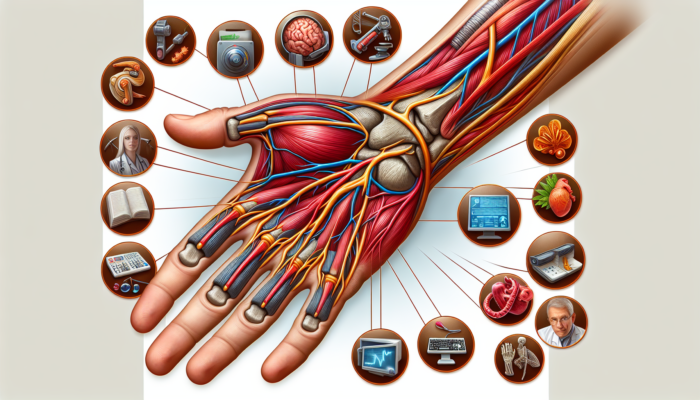Unlock the Healing Potential of Acupuncture for Effective Carpal Tunnel Syndrome Relief
Acupuncture has emerged as a highly regarded treatment modality for individuals grappling with the debilitating impacts of carpal tunnel syndrome. This time-honoured healing practice not only alleviates pain but also targets the underlying causes of discomfort that many endure. If you are experiencing troubling sensations like numbness, tingling, and a sense of weakness in your hands and wrists, gaining an understanding of how acupuncture for carpal tunnel relief works can be transformative. This detailed article will delve into the complexities of carpal tunnel syndrome, the essential role that acupuncture plays in alleviating its symptoms, and the broad spectrum of benefits available to those affected.
Understanding the Intricacies of Carpal Tunnel Syndrome

Gaining In-Depth Knowledge About Carpal Tunnel Syndrome
Carpal tunnel syndrome (CTS) is a prevalent condition that manifests as a variety of uncomfortable sensations in the hand and arm. This disorder occurs when the median nerve, which runs through the carpal tunnel of the wrist, becomes compressed. Such nerve compression can lead to symptoms that severely disrupt daily activities and diminish one’s overall quality of life. A comprehensive understanding of this condition is imperative for individuals seeking effective treatment options, including acupuncture for carpal tunnel relief. By familiarising yourself with CTS, you empower yourself to navigate the path toward healing and improved well-being.
Recognising the Symptoms Associated with Carpal Tunnel Syndrome
Individuals suffering from carpal tunnel syndrome often report a distressing range of symptoms, which may encompass:
– Persistent pain that radiates from the wrist into the hand.
– Numbness or tingling sensations that spread into the fingers.
– Noticeable weakness in grip strength, rendering simple tasks like holding objects increasingly challenging.
These symptoms can profoundly disrupt not only sleep patterns but also daily routines, prompting many individuals to pursue effective remedies such as acupuncture for carpal tunnel relief to regain control of their lives and enhance their overall health.
Examining the Underlying Causes and Risk Factors for Carpal Tunnel Syndrome

Gaining insight into the underlying causes of carpal tunnel syndrome is vital for creating effective treatment and prevention protocols. Several common risk factors contribute to the development of this condition, including:
– Repetitive hand use: Engaging in activities requiring prolonged wrist flexion, such as typing or assembly line tasks, can significantly elevate the risk of developing CTS.
– Wrist injuries: Previous trauma to the wrist may increase the likelihood of nerve compression and subsequent symptoms.
– Health conditions: Certain medical conditions, including diabetes, rheumatoid arthritis, and thyroid disorders, can also raise the risk of developing CTS.
By recognising these risk factors, individuals can empower themselves to take proactive steps towards preventing the onset of symptoms and seeking timely interventions when necessary.
Understanding How Acupuncture Provides Relief from Carpal Tunnel Syndrome
Exploring the Fundamental Principles of Acupuncture
Acupuncture is deeply embedded in the principles of Traditional Chinese Medicine (TCM), which posits that a vital energy known as ‘qi’ flows through specific pathways within the body. By stimulating designated acupuncture points, practitioners aim to restore balance and alleviate pain. This ancient healing modality transcends mere needle insertion; it embodies a holistic approach to health that addresses both symptoms and the underlying imbalances contributing to the condition, fostering a more comprehensive health experience.
Identifying Key Acupuncture Points for Targeted Relief from Carpal Tunnel Syndrome

Several specific acupuncture points have demonstrated remarkable efficacy in providing acupuncture for carpal tunnel relief. Notable points include:
– PC6 (Neiguan): Located on the inner forearm, this point is renowned for its ability to alleviate wrist pain.
– LI4 (Hegu): Situated on the hand, this point is widely acknowledged for its potent pain-relieving properties.
– TH5 (Waiguan): Positioned on the outer forearm, this point effectively reduces inflammation.
Focusing on these crucial points can enhance blood circulation and relieve nerve pressure, effectively addressing the symptoms associated with carpal tunnel syndrome while promoting a profound sense of relief.
Understanding the Mechanisms of Pain Relief Facilitated by Acupuncture
The effectiveness of acupuncture in alleviating pain is primarily attributed to its capacity to diminish inflammation and relieve nerve pressure. By stimulating specific acupuncture points, the body releases endorphins, which are natural painkillers that induce relaxation and comfort. Additionally, acupuncture improves circulation, ensuring that essential nutrients reach the affected areas, thereby promoting recovery and healing processes.
Research Evidence Supporting Acupuncture as an Effective Treatment for Carpal Tunnel Syndrome
A growing body of scholarly evidence substantiates the efficacy of acupuncture in treating carpal tunnel syndrome. Numerous studies indicate that patients who undergo acupuncture treatment report significant reductions in pain levels and enhancements in hand functionality. This compelling evidence positions acupuncture as a credible and effective alternative to traditional treatment options, offering renewed hope to those in search of relief.
Discovering the Multiple Benefits of Acupuncture for Carpal Tunnel Syndrome
Why Non-Invasive Treatment Approaches are Highly Favoured
One of the most appealing aspects of acupuncture is its non-invasive nature. Unlike surgical procedures which may involve substantial risks and lengthy recovery periods, acupuncture presents a safer alternative that does not rely on medication or invasive techniques. This makes it an attractive option for individuals seeking effective and compassionate relief from carpal tunnel syndrome.
Realising Significant Reductions in Pain and Inflammation
Many patients report immediate and sustained relief from pain and inflammation through acupuncture. Numerous individuals find their symptoms improve markedly after just a few sessions, making this treatment a compelling choice for those seeking rapid and effective results.
Enhancing Hand Functionality and Dexterity Through Regular Acupuncture Treatments
Consistent acupuncture sessions can lead to notable improvements in grip strength and hand dexterity, enabling individuals to resume daily tasks with greater ease and efficiency. This enhancement is particularly beneficial for those whose professions require fine motor skills, allowing them to perform their duties more effectively and with reduced discomfort.
Adopting a Holistic Health Perspective Through Acupuncture
Acupuncture perceives the body as an interconnected whole rather than isolating symptoms. This holistic viewpoint can result in overall health enhancements, addressing not only the pain associated with carpal tunnel syndrome but also any underlying imbalances that may exist, thereby promoting a deeper sense of well-being.
Preparing for Your Acupuncture Session: Key Steps for Optimal Success
Choosing a Qualified Acupuncturist for Maximum Treatment Effectiveness
Selecting a certified and experienced acupuncturist is essential for ensuring a successful treatment experience. Seek practitioners with relevant qualifications and favourable patient testimonials. A proficient acupuncturist will possess a deep understanding of the techniques and subtleties involved in effectively treating carpal tunnel syndrome, thus increasing the likelihood of achieving satisfactory outcomes.
What to Expect During Your Initial Acupuncture Consultation
During your first consultation, the acupuncturist will conduct a thorough evaluation of your symptoms and medical history, creating a tailored treatment plan that aligns with your specific needs. Be prepared to discuss your particular concerns, as this dialogue will assist in crafting a personalised approach to your acupuncture for carpal tunnel relief.
Pre-Session Tips for Maximising Your Acupuncture Experience
To optimise the effectiveness of your acupuncture experience, consider implementing the following pre-session strategies:
– Maintain adequate hydration to support your body’s response to treatment.
– Avoid caffeine consumption, as it can obstruct relaxation and comfort during the session.
– Wear loose-fitting clothing to facilitate easy access to acupuncture points.
These simple yet effective measures can significantly enhance the outcomes of your acupuncture session, setting a solid foundation for successful treatment.
Exploring Advanced Acupuncture Techniques for Enhanced Carpal Tunnel Relief
Understanding the Various Needle Insertion Techniques Employed in Acupuncture
Acupuncturists utilise a range of needle insertion techniques, varying from shallow to deep, depending on the specific acupoint targeted and the comfort level of the patient. This adaptability ensures that each session is customised to meet individual needs and preferences, thereby maximising the potential benefits of treatment.
Enhancing Treatment Outcomes with Electroacupuncture
Some practitioners incorporate electroacupuncture, a technique that involves applying electrical stimulation to the needles, thereby enhancing treatment outcomes. This method can amplify the effects of acupuncture, providing quicker pain relief and facilitating the body’s healing processes.
Combining Acupuncture with Cupping Therapy for Optimal Therapeutic Results
Integrating acupuncture with cupping therapy can yield superior therapeutic outcomes. Cupping therapy creates suction on the skin, enhancing blood flow and alleviating muscle tension, which complements the effects of acupuncture and improves overall treatment efficacy.
Utilising Moxibustion for Amplified Therapeutic Relief
Moxibustion, which involves applying heat to specific acupuncture points, can intensify the relief experienced. This technique enhances circulation and alleviates discomfort, making it an invaluable addition to acupuncture treatments for carpal tunnel syndrome.
Integrating Acupuncture with Complementary Treatment Strategies
Enhancing Results by Combining Acupuncture with Physical Therapy
Pairing physical therapy with acupuncture can be exceptionally beneficial. Targeted exercises designed to strengthen the wrist and hand muscles can enhance the <a href="https://limitsofstrategy.com/acupuncture-benefits-for-menstrual-pain-relief-guide/">pain relief</a> achieved through acupuncture, ultimately promoting better functionality and mobility in the affected areas.
Chiropractic Care: A Complementary Approach to Boost Acupuncture Treatment Effectiveness
Chiropractic adjustments can improve overall wrist and hand health by correcting any misalignments that may contribute to carpal tunnel syndrome. By integrating chiropractic care with acupuncture, patients can optimise their treatment outcomes and achieve comprehensive relief.
Massage Therapy: A Synergistic Method for Enhanced Healing
Massage therapy techniques can effectively alleviate muscle tension and improve circulation, working synergistically with acupuncture to achieve optimal results. Regular massage can help sustain the benefits of acupuncture sessions, supporting long-term relief and recovery.
Boosting Acupuncture Results with Herbal Medicine
Incorporating herbal medicine can further enhance the positive effects of acupuncture. Certain herbal supplements are recognised for their ability to reduce inflammation and promote healing, creating a holistic approach to managing carpal tunnel syndrome and its associated challenges.
Inspiring Success Stories: Real-Life Experiences with Acupuncture
Case Study 1: A Musician's Triumph Over Pain and Path to Recovery
Consider the motivating story of a musician who suffered from debilitating wrist pain. After undergoing a series of acupuncture sessions, they experienced remarkable relief, enabling them to return to their passion for playing music without discomfort and rediscovering their love for their art.
Case Study 2: An Office Worker’s Victory Over Chronic Wrist Pain
An office worker grappling with chronic wrist pain discovered success through acupuncture. With consistent treatments, they regained hand functionality, allowing them to perform their job duties without interruption, which significantly enhanced both productivity and overall quality of life.
Case Study 3: A Mother’s Relief Experience During Pregnancy
A mother who experienced carpal tunnel symptoms during her pregnancy found that acupuncture provided her with much-needed relief. This non-invasive treatment option allowed her to navigate her pregnancy comfortably, greatly improving her overall well-being during this critical time.
Case Study 4: An Athlete’s Journey Back to Peak Performance Through Acupuncture
An athlete determined to achieve peak performance turned to acupuncture to address lingering wrist pain. After several sessions, they reported significant improvements, enabling them to return to training and competition, thus supporting their athletic aspirations and goals.
Addressing Your Frequently Asked Questions About Acupuncture for Carpal Tunnel Syndrome
What Is the Suggested Frequency of Acupuncture Sessions for Best Results?
Typically, a range of 6-12 sessions is recommended for achieving significant relief; however, the exact number may differ based on the severity of symptoms and individual responses to treatment.
Is the Acupuncture Procedure Painful for Most Patients?
Most patients experience minimal discomfort during acupuncture sessions, often describing the sensation as a slight prick or mild tingling, which is generally well-tolerated.
Can Acupuncture Offer a Complete Cure for Carpal Tunnel Syndrome?
While acupuncture may not provide a complete cure for carpal tunnel syndrome, it can significantly alleviate symptoms and enhance overall well-being, making it a valuable component of a comprehensive treatment strategy.
Are There Any Potential Side Effects Associated with Acupuncture?
Side effects are rare; however, they may include bruising or soreness at the needle insertion sites, which typically resolves quickly following treatment.
How Long Can I Expect the Results of Acupuncture to Last?
The duration of results can vary; however, many patients report enjoying long-lasting relief, especially with regular maintenance sessions to sustain the benefits.
Connect with us on Facebook for More Insights and Updates!
The Article: Acupuncture for Carpal Tunnel: Essential Relief Guide appeared first on https://mcrtherapies.co.uk
The Article Acupuncture for Carpal Tunnel: Your Essential Relief Guide appeared first on https://mcrtherapies.com
The Article Acupuncture for Carpal Tunnel: Essential Relief Strategies Was Found On https://limitsofstrategy.com


I found your insights on acupuncture for carpal tunnel syndrome very enlightening. Having recently explored alternative therapies myself, I can appreciate the importance of addressing not just the symptoms but also the root causes of conditions like CTS. It’s fascinating how acupuncture, a practice rooted in ancient traditions, continues to hold relevance in our modern health landscape.
I appreciate your thoughts on acupuncture and its role in addressing carpal tunnel syndrome. It’s true that exploring alternative therapies can open up new avenues for healing. With conditions like CTS, it often feels like a cycle of treating symptoms without digging deeper into the underlying issues that lead to the discomfort.
I’m glad you found the insights valuable! If you’re interested in exploring more about acupuncture and its benefits for conditions like CTS, check out this resource for further information and guidance.
https://redhillopticians.co.uk/FaceTune
I completely resonate with what you’ve said about addressing the root causes of conditions like carpal tunnel syndrome. It’s true that so many treatments focus solely on alleviating symptoms rather than understanding the underlying issues. I’ve always found it enlightening how ancient practices like acupuncture can still provide valuable insights into our modern health challenges.
You bring up a really important point about how many treatments focus mainly on the symptoms instead of digging deeper into what’s causing issues like carpal tunnel syndrome. It’s so easy to get caught up in relief methods—like splints, anti-inflammatories, or even surgery—while the real question often gets pushed aside. Why are we experiencing these symptoms in the first place?
It’s interesting how the conversation around conditions like carpal tunnel syndrome often gets eclipsed by a focus on quick fixes. So much emphasis is placed on what can be done in the moment—whether it’s splints, painkillers, or even surgery—while the deeper questions often go unasked. Tackling those root causes not only encourages better health in the long run but also sheds light on the broader picture of how our bodies function.
“I’m glad to hear you share the same perspective! If you’re interested, you might find this resource on integrating traditional practices with modern treatment approaches quite insightful.”
https://redhillopticians.co.uk/VideoLeap
It’s great to hear that you connect with the idea of addressing the root causes of things like carpal tunnel syndrome. It’s surprising how often we’re just handed a quick fix without anyone digging deeper into what’s really going on. Your point about acupuncture is spot on. It’s fascinating how practices that are thousands of years old can still hold relevance today.
You make a great point about focusing on root causes rather than just treating symptoms. It’s interesting to see how many of us have fallen into this way of thinking, especially with something like carpal tunnel syndrome. Many treatments seem to offer quick fixes, like splints or pain relievers, but these often fail to address the habits or behaviors that lead to the problem in the first place.
I’m glad to hear you resonate with this perspective! If you’re interested in exploring more about holistic approaches, including acupuncture, check out this resource that delves deeper into addressing root causes and enhancing overall well-being.
https://redhillopticians.co.uk/ChocolateHealth
It’s great to hear that you’re exploring alternative therapies yourself. Acupuncture really does have this intriguing blend of ancient wisdom and modern medical applications. Carpal tunnel syndrome can feel overwhelming, especially with all the different options available. What I find interesting is how acupuncture addresses the whole person rather than just the symptoms. It encourages a shift in perspective—seeing discomfort as a signal our bodies are sending us, rather than just something to mask.
It’s refreshing to hear that you’ve explored alternative therapies and are considering the broader context of conditions like carpal tunnel syndrome. While acupuncture can be effective for many, it’s worth noting that the efficacy can vary significantly from person to person. Some find real relief, while others might only get minimal benefits.
It’s great to hear that you’ve been diving into alternative therapies, especially in the context of carpal tunnel syndrome (CTS). You’re touching on something quite significant when you mention addressing root causes over merely alleviating symptoms. Many people often find themselves caught in a cycle of treatments that offer temporary relief but don’t really tackle the underlying issues.
I’m glad you found the insights helpful! If you’re interested in exploring how acupuncture can further support your journey toward wellness, check out this resource to learn more about its benefits.
https://redhillopticians.co.uk/consult